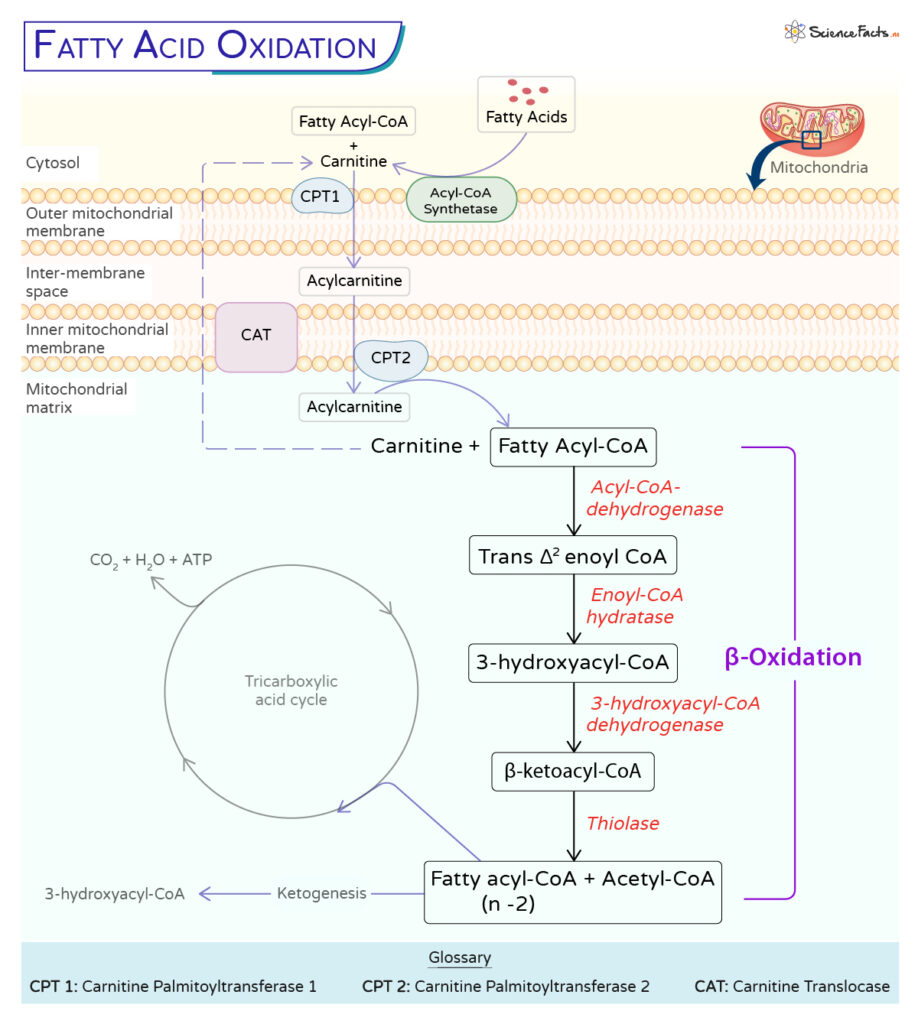Where Does Beta Oxidation Occur
Activation of Fatty Acid in the Cytosol
Formation of Acyl-Carnitine
Translocation into the Mitochondrial Matrix
Beta Oxidation in the Mitochondria
Products of Beta Oxidation
Steps
This process involves four steps:
1. Dehydrogenation
The first step of beta-oxidation involves the oxidation of fatty acyl-CoA by the enzyme acyl-CoA-dehydrogenase, which adds a double bond between the α(C2) and β(C2) carbons of the molecule, forming trans-Δ2 enoyl CoA.
2. Hydration
Next, a water molecule is added to the trans-double bond in a reaction catalyzed by enoyl-CoA hydratase. This step forms a hydroxyl group on the β carbon, a compound known as 3- hydroxyacyl-CoA.
3. Oxidation
The hydroxyl group is then oxidized to a keto group to form beta-ketoacyl-CoA by 3-hydroxyacyl-CoA dehydrogenase, restoring the trans-double bond and generating an NADH.
4. Thiolysis
The final step involves cleaving the terminal acetyl-CoA group (β-ketoacyl-CoA) by thiolysis, releasing fatty acyl-CoA with a fatty acid chain shortened by two carbons. The enzyme thiolase catalyzes this reaction. Thus, for each round of beta-oxidation, two carbon atoms are successively removed from the fatty acid chain. These four steps are repeated until the entire fatty acid is broken into acetyl-CoA units. Thus, it is an iterative process. The overall equation of one cycle of beta-oxidation is: Acyl-CoA (Cn)+ FAD + NAD+ + H2O + CoA → Acyl-CoA (Cn-2)+ FADH2 + NADH + H+ + Acetyl-CoA The fate of the acetyl-CoA from fatty acid oxidation depends on the organism’s need. It may enter the citric acid cycle for oxidation or serve as the starting material for synthesizing fatty acids. Once the acetyl-CoA enters the citric acid cycle, it contributes to the production of ATP through oxidative phosphorylation.
Yield of ATP
The amount of ATP synthesized from a single round of fatty acid degradation depends on the size of the fatty acid oxidized. For example, after complete degradation, palmitic acid (a 16-carbon saturated fatty acid) forms 8 mol of acetyl-CoA. It requires the four steps to be repeated seven times, producing 7 mol of NADH and 7 mol of FADH2. The total net yield of ATP from one molecule of palmitic acid is summarized below: Oxidation of 1 mol of palmitic acid produces 2,340 kcal of energy. C16H32O2 + 23O2 → 16CO2 + 16H2O + 2,340 kcal
